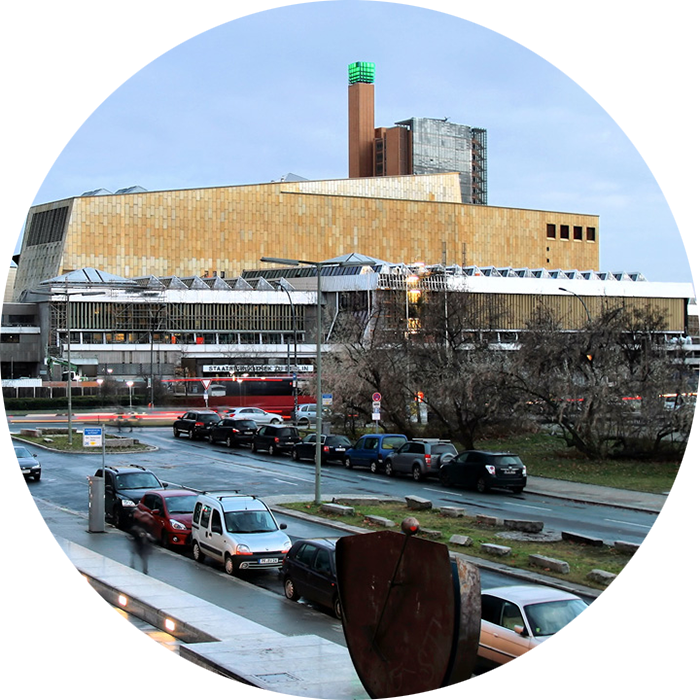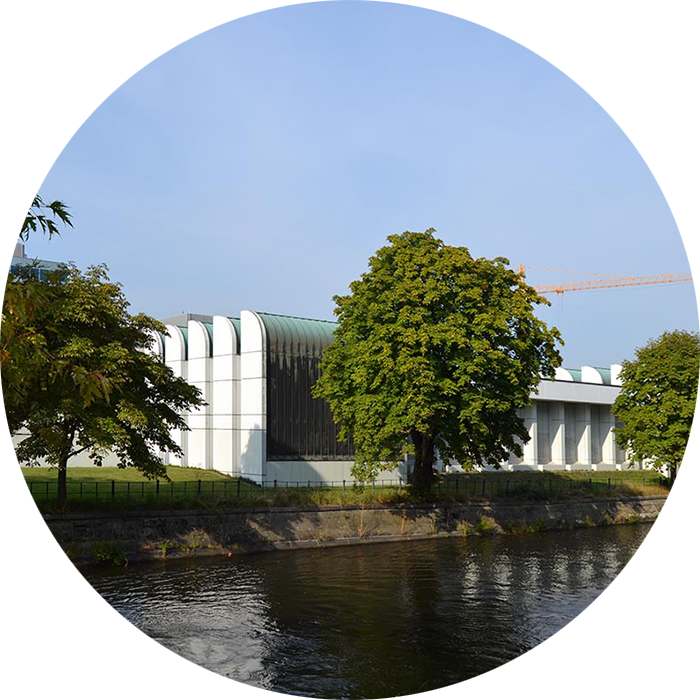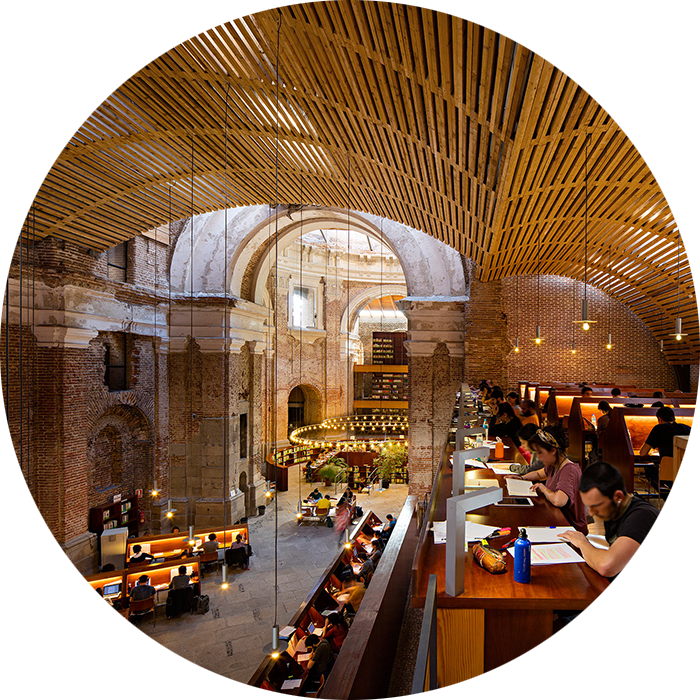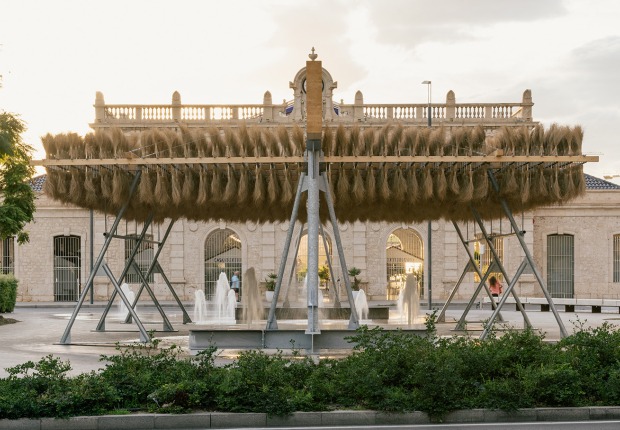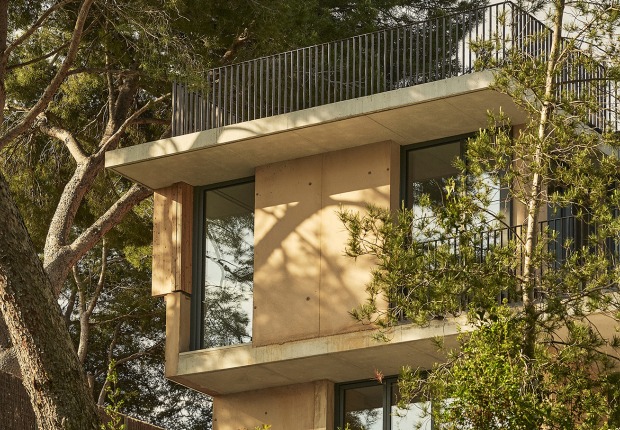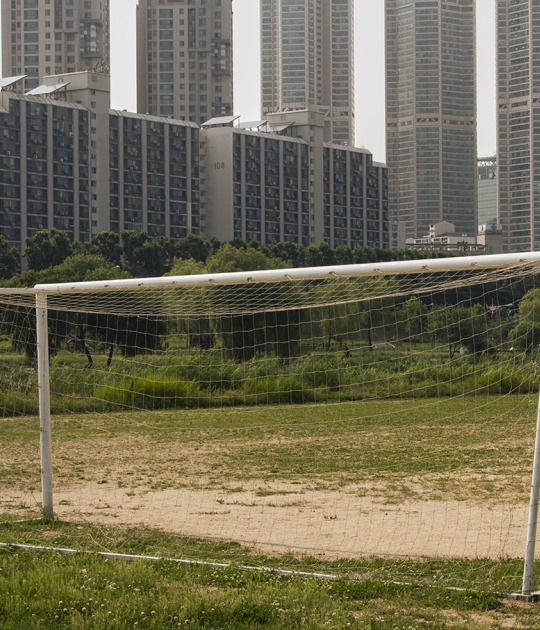When talking about libraries, places of reading and study come to mind where silence and concentration reign, within an atmosphere of peace and tranquility, but a library is not only characterized by its function within society, but also by the conception within the urban fabric that can be transmitted at an architectural level.
That is why we present 10 classic libraries that you should know to show how these incredible structures can influence the life of society through time only through their architectural composition, their play of light, their materiality, or their constructive development through the length of time.
1. Beinecke rare book & manuscript library

That is why we present 10 classic libraries that you should know to show how these incredible structures can influence the life of society through time only through their architectural composition, their play of light, their materiality, or their constructive development through the length of time.
1. Beinecke rare book & manuscript library

The Beinecke Library of Rare Books and Manuscripts, belonging to Yale University, in New Haven, Connecticut, in the United States, was built between 1960 and 1983 under the command of Gordon Bunshaft, of the firm of Skidmore, Owings and Merrill and modernized in 1990, is projected as one of the buildings largest in the world dedicated to books and manuscripts, housing 180 thousand copies in the central tower, 600,000 on the shelves, plus 500,000 volumes along with several million manuscripts, so that the control of light and temperature plays an important role in the project to preserve and protect as best as possible all this material.
This library was built in response to the interest that had begun to be created in the late 1950s for rare books and special collections, so Gordon Bunshaft designed the building with Vermont marble and granite, bronze and glass was projected, each material designed to complement with the following, in addition to contrasting on the rest of the older buildings of Hewitt University, but not only for its material composition but also for its function as a research center for the entire public.
The project begins by introducing the main access through a revolving glass door, which leads to a glass tower where thousands of books are stored in height as the central nucleus of the space, which is divided in two through stairs on each side of the mezzanine, created as an exhibition point for the library's collections. Below ground, you can find a research center as one of the smallest spaces where a large number of areas are housed such as office space, bookshelves, classrooms, a study area, and a garden patio designed by Isamu Noguchi, and whose roof functions as a plaza and a point of reference within the University, since the whole of the project could be represented as a large exhibition marble cube.
In 1927, a competition was called for the construction of a municipal library in the then Finnish city of Viipuri, which was won by Alvar Aalto through a design that was not determined until 1935 due to various modifications. Finally, the library was built with a functionalist and modern design, representative of the architect in his projects from the pre-war era, offering him, little by little, worldwide recognition and the possibility of exhibiting, in 1938, various designs, of the International Style, of its architecture in the Museum of Modern Art (MoMA).
But, mainly due to the Second World War, the change of borders, from Viipuri to Vyborg under the control of the Soviet Union, the library was damaged and later abandoned without the possibility of restoration until 1950, where a series of restorations were carried out. little-studied about the techniques and design of Alvar Aalto, so that little by little, from 1970 and 1980, with the dissolution of the Soviet Union, a desire to preserve the original architectural values was created, studying the needs of the building. It is in 1992, when the Finnish Committee for the Restoration of the Viipuri Library was created, giving way to its entry into the World Monuments Watch in 2000 and 2002, an entity that through a large donation led to the restoration of a large part of elements of the reading room and the lending library, officially completing the restoration in 2013.
And it is not until the following year, 2014, that through the World Monuments Fund (WMF) it is announced that Alvar Aalto's Viipuri Library, located in Vyborg, Russia, has won the "2014 World Monuments Fund / Knoll Modernism" award. , awarded to the "Finnish Commission for the Restoration of the Viipuri Library" at the Museum of Modern Art (MoMA) in New York on December 1, 2014, thanks to its final design through history and its clear functionalist design representative of the architecture of Alvar Aalto.
The Staatsbibliothek or National Library of Berlin was designed between 1967 and 1978 by Hans Scharoun and Edgar Wisniewski along the same lines as Scharoun's Berlin Philharmonic at the Kulturforum. Its construction began with a first proposal by Werner Düttmann for a new library in Kemper Platz, which was rejected, so in 1963 the construction of the library in the Kulturforum was called for competition, and it was Hans Scharoun who did it. It won in 1964, but it was not until 1967 when it began to build within a framework of fights and conflicts, and which later was relegated to Edgar Wisniewski, from the death of Scharoun in 1972 until the completion of the work in 1977, inaugurated finally in 1978 accompanied by several reforms, extensions, and adaptations between 1991 and 2015.
However, not everything was so continuous in time, since due to World War II, the Berlin National Library was divided into two parts, one of them within the western area, under the control of the Soviets, which was located again in the original building on Unter den Linden Avenue and the other in the hands of the allies, that is why the library has two areas, Headquarters 1, the old building and Headquarters 2, the proposal made by Scharoun and Wisniewski, which are currently connected, under the name of “a library in two houses”, to reconstitute the Staatsbibliothek Zu Berlin as part of the Prussian National Heritage.
The project is located on a triangular block heading north between the Theater am Potsdamer Platz and the Spielbank Berlin, designed by Renzo Piano, which functions as a division between the Kulturforum, the death strip, and the Berlin Wall, and stands out for its apparent massiveness coming from the golden facade of 42 meters high, almost without openings, in homage to the works of Scharoun, which also provided the building with a large glass facade through which natural light penetrates the area of reading and is complemented by skylights and terraces interconnected by stairs.
The development of the Bauhaus archives project begins with the initial construction of the Bauhaus, founded by Walter Gropius in 1919 under the name "Das Staatliches Bauhaus", as an art school, and currently as a center of avant-garde and movement modern art, from its inception until 1933, under the control of Gropius until 1927, Hannes Meyer until 1930 and finally Mies van der Rohe until 1933. But it was Hans Maria Wingler, in 1960, with the help of Gropius, who showed interest in creating a project aimed at the study and debate on the historical tradition of the modern that will house the institute and the historical documentation of the Bauhaus, so together with Wils Ebert, Alexander Cvijanovic, Louis McMillen and Gropius, between the years 1964 In 1968, he began to build the building as a stepped structure divided into two parallel wings and at different heights, characterized by the use of skylights on the north side.
But for financial reasons, its location changes and it is transferred to West Berlin, no longer under the supervision of Gropius, who died in 1969, but under the command of a former employee of his, Alex Cvijanovic, together with the architect Hans Bandel, they carry out the reprogramming of the project and It was built between 1976 and 1979, using the basic organization of the Darmstadt model, which led to a necessary new rethinking of the project and the appearance of a series of modifications, within which Cvijanovic, out of respect for Gropius, decided to keep the Original formal elements such as the differentiation of the construction bodies, the morphology of the ramp that gives access to the first floor or the roof, together with the structural separation of the space according to its functionality, permanent exhibition and temporary exhibition vs the archive and the administration
After several years after its completion, with the fall of the Berlin Wall in 1989, the Bauhaus Archive grew in importance, and it was in 1977 when it was declared a National Monument as the last legacy to the architecture of Walter Gropius, who later In 2019, the new construction of a museum to the project will conclude.
5. La Bibliothèque Nationale de France by Dominique Perrault, portrait d´un projet 1988-1998, Exhibition at the BnF

By order of President François Mitterrand in 1988, the National Library of France was built on the outskirts of the city of Paris, and it was in 1989 that the architect Dominique Perrault was awarded for this great project, along with other important ones such as the Grand Louvre, the Opéra Bastille or the Institut du Monde Arabe, for the construction of an emblematic building, from which a new district of the city is born, based on the architectural concept of "Groundscape", an underground architecture capable of redefining nature to design the urban contours of the city.
That is why the BnF has made an exhibition: "Dominique Perrault - The National Library of France, Portrait of a project 1988 - 1998", in commemoration of the construction process of this contemporary architecture marked by conflicts and great design experimentation, not only at the specific level of the François-Mitterrand Library project but on a more urban scale within its location, which is finally exhibited in four areas: the architectural object, the monument and the territory, the garden, the materials, and the furniture, reflected in plans and original documentation, as well as models and the furniture designed by the architect.
The Seattle Central Library, designed by OMA in collaboration with LMN Architects, was created as a result of a state of threat to libraries within the digital age, which is why public space is projected to transmit and store information, redefining the concept library, where 748,000 books and 710,000 additional books are organized through the Books Spiral system, vertically divided into 5 levels, where OMA organized "stable" programs (parking, staff, meeting, spiral of books, headquarters) and 4 plans of "unstable" programs (children, living room, mixing chamber, reading room) connected and intertwined with each other, which determine the shape of the façade, since each space is designed architecturally different from the rest, at a structural, formal or circulation level.
But characterizing the project, the Mixing Chamber can be highlighted as one of the spaces with the greatest interaction within the project as a whole, between staff and users, where the former guide the reader to the Books Spiral, a continuous ramp of shelves. and organic, with a much greater storage capacity than there is currently, without modifying the structure or adding more elements. This area creates an area of structural frameworks similar to a bridge, which can be seen at night through its façade, resembling the interior of a lantern that projects the forms towards the urban landscape, turning the whole into a project to contemplate within the plot that surrounds him.
The Maison de la littérature (House of Literature) has been designed by Chevalier Morales Architectes, located in the former Old Quebec quarter, a UNESCO World Heritage Site, and was designed as a simple and delicate expansion of what was the previous Temple of Wesley, a former Neo-Gothic church, eventually became a well-traveled destination in Old Quebec. The project was born as a result of an architecture competition, which Chevalier Morales Architectes wins with the design of a new volume attached to the temple, with the same functionality, also achieving communication between the two architectural styles, while efficiently achieving, to be implanted in the context of the Québec neighborhood, through an innovative and elegant proposal, which not only had a library but also included a concert/conference room, a cafeteria, a temporary exhibition space, an exhibition permanent residence, the apartment of a resident writer, creation studios, a projection room and a classroom as a multimedia studio.
These project decisions helped transform the Wesley Temple into a public library and concert and conference hall for the Institut Canadien, thus offering better access and continuity of space as one of the oldest public libraries in the province of Quebec. . This adhesion gives the Institut Canadien a transparent and familiar shape, with a roof made of glass panels, which offers it the possibility of blending in with the urban environment, introduced inside through the main door of the temple or the parking lot, converging both in a large circular opening in the floor next to a central set of lights, thus vertically connecting the cafeteria, two exhibition areas, and the library collections, the latter bathed in light and white tones, accessible through a sculptural staircase spiral that gives rise to original elements such as moldings on the ceiling or pointed windows along with more contemporary furniture.
The solution presented for this new annex is mainly aimed at showing, complementing, and preserving the heritage value of the existing building, avoiding altering the architectural composition by establishing a dialogue through the materials and transparency of the project, thus creating a connection between the past and the present of the historic district of old Quebec City.
At the request of the city of Stockholm, Caruso St John Architects in collaboration with Scheiwiller Svensson Arkitektkontor will undertake the restoration and expansion of the Gunnar Asplund Library, designed by Gunnar Asplund himself and inaugurated in 1928, as one of the best works of architecture. modern in the country of Sweden and worldwide, also being the first to offer direct access to the user to the shelves. That is why the renovation of the library is considered as something necessary, especially in terms of the main building and the annexes that unite the structure and accessories.
The city has chosen Caruso St John Architects for their conviction that they believe they are the most successful to carry out this process of restoration and restructuring, suspended since 2009, as they have demonstrated clear experience in the rehabilitation of historical and cultural buildings is concerned, so the study in response to the confidence provided will focus its intervention on the reorganization of the interior spaces of the building, which will be re-planned to help the library adapt to contemporary demands, after an exhaustive analysis of the shortcomings of the program and structure.
In the 3rd edition of Open House Madrid, one of the buildings to present is the UNED Escuelas Pías headquarters designed by José Ignacio Linazasoro, located in Lavapiés, the last "old" neighborhood of Madrid, built between 1996 and 2004 as a dialogue between the present and the past which also characterizes the neighborhood where ancient and modern architecture coexist in harmony, attesting to the coexistence of the ruins of the old Pious Schools of San Fernando and the emptiness of the Plaza de Agustín Lara, both survivors of the Civil War, the church which showed the resistance of the structure of its walls, hidden behind the veil of stucco and excessive furniture.
The project is carried out in these ruins and on the site next to them, considering it as an action for urban reorganization around the square. In the new site, Linazaroso proyected a University Lecture Hall and in the ruins, a library, built-in unity and under the influence of the ruins themselves, but with different spaces and construction systems that give each project uniqueness, contrasting some elements of modern architecture with allusions and quotes from the past, giving the intervention its character, also defined by the use of sets of mirrors to reflect in each corner the imposition of each area of the project, so the incidence of each project will be taken into account. composition material and texture.
The Regional Archive of the Community of Madrid and the Joaquín Leguina Regional Library, both as part of the complex of the old El Águila Beer Factory, have been designed by the architects Tuñón and Mansilla. The El Águila Beer Factory was founded in 1900 and built by Eugenio Jiménez Correa and its rehabilitation spanned the years between 1996 and 2002, being today one of the most interesting examples of industrial architecture that remain in Madrid, which originally consisted of ten buildings and their streets, on a large lot. This architecture was characterized by not being different from other constructions since in Spain they were built in brick, providing it with certain rationality, that is why all the facades of the factory are built with uncoated exposed brick, influenced by neo-Mudejar architecture
But with the appearance of the Civil War, the factory changed hands for a few years, which meant that when it was returned to its original owners, there had already been numerous extensions and modifications, and things got worse when in 1978 the COAATM concluded the residents of the area that the factory had lost all architectural interest so it was abandoned in the 1980s. But things changed when in 1990 it was declared "Asset of Cultural Interest" and in 1994 a contest was called to rehabilitate the function of its interior, a contest won by Emilio Tuñón Álvarez and Luis Moreno Mansilla, who ended up projecting the new Regional Library and the Regional Archive of the Community of Madrid, which was originally going to be a center for artistic expression.
The Regional Archive is made up of 3 separate modules according to their function: income, deposits, and customer service, and the Regional Library is built based on a diversified program focused on a multimedia library that reuses the different industrial spaces that were there. Both projects have the purpose of preserving, guarding, and disseminating the historical heritage, and although they are separated, they are built unitarily following the original idea of industrial architecture, but mixing it with the modern one, definitely integrating the whole in the urban fabric.



